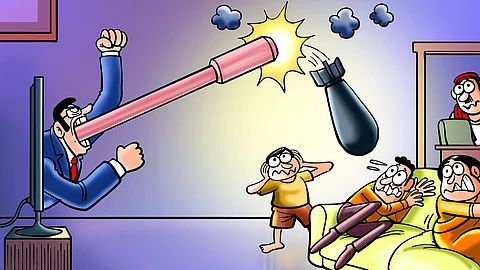
During the recent escalation between Pakistan and India, Indian media drew severe criticism for crossing all limits of propaganda and false reporting. In its quest for ratings, the Indian media abandoned journalistic ethics and objectivity, fueling war hysteria and manipulating public sentiment.
The controversy began with an attack in Pahalgam, located in Indian-administered Kashmir, on April 22, which claimed 26 lives.
India swiftly blamed Pakistan and, on May 7, claimed to have conducted a cross-border strike under the banner of "Operation Sindoor," alleging it had targeted terrorist camps in Pakistan and Azad Kashmir. A ceasefire was announced three days later following U.S. intervention.
However, the Indian media’s aggressive coverage, marked by unverified claims, sensational headlines, and inflammatory rhetoric, was widely ridiculed not only in Pakistan but also by critical voices within India.
Bushra Iqbal Hussain, a journalism trainer based in Islamabad, stressed that truth and impartiality are the cornerstones of journalism. "A journalist must separate personal bias and emotion from the news. Only facts, verified data, and neutrality should define reporting," she said.
Also Read: Peace Committee Member Shot Dead in Khyber, Police Constable Killed in Separate Bannu Attack
Unfortunately, she noted, Indian media flagrantly violated these principles during the conflict. "The media deliberately escalated the narrative of war, chasing ratings and online engagement through provocative language and dramatic presentation."
Bushra added that the collusion between media outlets and the Indian government and establishment cannot be ruled out. "Fake news was strategically used to paint Pakistan as a terrorist state and justify military aggression. Media platforms were exploited to amplify the official narrative," she explained.
Dr. Bakht Zaman, professor of journalism at the University of Peshawar, remarked on the entertainment-style approach of Indian newsrooms. "India's film industry has a global reputation, and their news media often mirrors this entertainment model. This leads to dramatization rather than serious reporting, burying the truth under spectacle."
Comparing the two countries’ media, Dr. Zaman observed that Pakistani outlets typically engage in more sober reporting, while Indian media, especially under Prime Minister Modi's government, exhibits extremist tendencies that affect both domestic minorities and international relations.
Veteran journalist Arshad Yousafzai cited historic examples of Indian media's misinformation, including the 2019 Pulwama attack, where India accused Pakistan without evidence and staged a so-called surgical strike in a deserted area of Balakot.
He also recalled India's 2021 claim of downing a Pakistani F-16, later disproven by a U.S. report confirming that all of Pakistan’s F-16s were intact.
Arshad argued that intense government and military pressure on Indian media has eroded press freedom. "Since the rise of the BJP, independent journalism has diminished. Most reporters are now compelled to echo the government’s narrative."
The greatest victim of fake news, experts agree, is the public. "It shapes perceptions, builds belief in falsehoods, and when the truth emerges, media credibility collapses," Bushra warned. “In times of conflict, the responsibility of media is immense. But when truth is replaced by propaganda and bias, peace is the first casualty.”
Bushra also noted that overly dramatic reporters who loudly demonize Pakistan often lose credibility among educated Indian audiences. "Their following is limited, and the discerning public sees through their exaggeration."
The issue is not confined to one nation—it poses a threat to the entire region. Irresponsible journalism amid tensions between two nuclear-armed states could lead to catastrophic consequences.
Now, more than ever, there is a dire need to return to truth, neutrality, and responsible reporting—so that facts prevail and peace, not war, finds a chance to thrive.